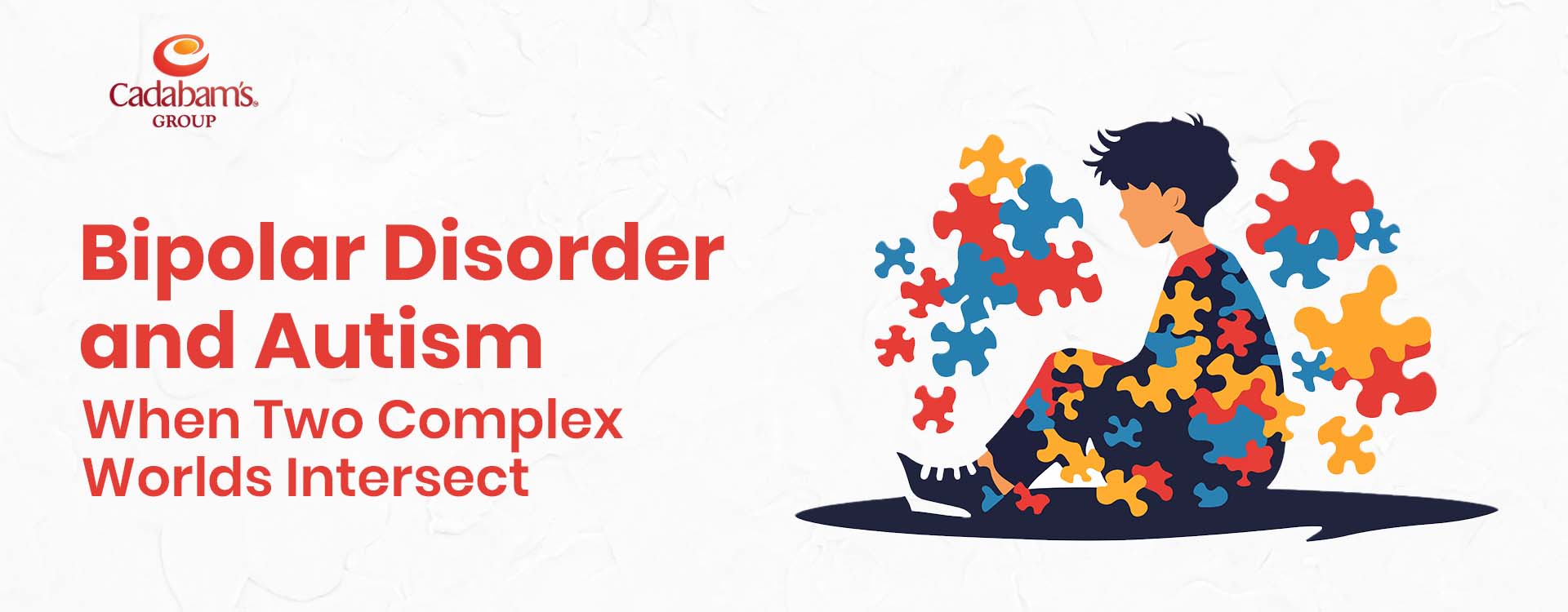This blog dives into unpacking autism spectrum disorder symptoms, variations on the spectrum, and early signs to watch for in children. You'll learn how ASD manifests differently in adults and explore the unique strengths that can come with high-functioning autism, along with treatment options and support systems for the same.
What is Autism Spectrum Disorder?
Autism Spectrum Disorder (ASD) is a lifelong neurodevelopmental disability affecting how people perceive and interact with the world. It's characterized by challenges in social communication and interaction, repetitive behaviors and interests, and sensory sensitivities. Autism spectrum disorder symptoms, as the name suggests, are present on a spectrum, meaning individuals experience these traits in varying degrees. While there's no cure, various therapies can significantly improve communication, social skills, and daily living for people with ASD.
The Importance of Early Diagnosis
Early diagnosis of ASD is crucial. It allows intervention to begin as soon as possible during a critical window for brain development. Early intervention can significantly improve social communication skills, reduce challenging behaviors, and empower individuals with ASD to reach their full potential.
Causes of Autism
The exact cause of Autism Spectrum Disorder (ASD) is not known as of now, but scientists believe a complex interplay of genetics and environmental factors is involved.
Genetics
There's a strong genetic link to ASD. Having a family member with ASD significantly increases a child's risk. Researchers have identified specific genes and chromosomal variations associated with ASD, though these may not directly cause it. It's more likely a combination of these genetic factors working together that contribute to ASD development.
Environmental factors
Environmental factors may interact with genetics to influence ASD risk. These factors are still being studied, but some potential contributors include:
- Prenatal Exposures: Exposure to specific factors during pregnancy, like air pollution or medications, might be linked to a higher risk.
- Advanced Parental Age: Parents, particularly mothers, who are older at the time of conception may have a slightly increased risk of having a child with ASD.
- Complications During Birth: Premature birth, low birth weight, and oxygen deprivation during birth can be risk factors.
It's important to note that these environmental factors are not proven causes and may not apply to everyone with ASD.
Core Symptoms of Autism
Autism Spectrum Disorder (ASD) is defined by a triad of core symptoms that appear in early childhood and can impact daily life.
Social Communication Challenges
Individuals with ASD may experience difficulties in various aspects of social communication. They might struggle with initiating conversations, taking turns talking, understanding nonverbal cues like facial expressions and body language, or interpreting humor and sarcasm. Forming and maintaining friendships can also be difficult.
Restricted, Repetitive Behaviors
Individuals with ASD often exhibit repetitive behaviors or have limited interests. This could include repetitive movements like hand flapping or rocking, lining up objects in a specific order, intense focus on a particular topic, or a strong need for routines and sameness. These behaviors can provide comfort and predictability but can also interfere with daily activities.
Sensory Sensitivities
Sensory processing differs in individuals with ASD. They may experience oversensitivity (hypersensitivity) to certain sights, sounds, smells, tastes, or textures. Loud noises, bright lights, or crowded environments can be overwhelming. Conversely, some individuals might have hyposensitivity, meaning they don't register sensory information as intensely as others. This could involve a seeming indifference to pain or a fascination with specific textures.
Early Signs of Autism in Children
Since early intervention is critical for maximizing potential in ASD, recognizing early signs is important. Here are some key areas to watch for:
Delayed Language Skills
These can include milestones like babbling or speaking first words being missed, difficulty understanding simple directions, or limited vocabulary. A child might also rely on echolalia, which is repeating words or phrases they hear or struggle to engage in back-and-forth conversation.
Lack of Social Interaction
Social interaction can be challenging for young children with ASD. They might not make eye contact, respond to their name consistently, or show interest in playing with others. They may also seem withdrawn or prefer solitary activities.
Unusual Behaviors and Interests
Repetitive movements like hand flapping, rocking, or lining up toys in a specific way are common. A child with ASD might have an intense focus on a particular topic, like dinosaurs or trains, and be resistant to changes in routine or environment. They may also exhibit unusual reactions to sensory stimuli, such as being bothered by loud noises or bright lights.
Autism Symptoms in Adults
Autism Spectrum Disorder (ASD) presents differently in adults compared to children. Diagnosis in adulthood is becoming more common, and here are some key signs to look for:
Challenges in Social Situations
Understanding social cues, nonverbal communication, and navigating social settings can be difficult for adults with ASD. They might struggle with interpreting facial expressions, body language, or sarcasm. Initiating and maintaining conversations, picking up on social cues, or making friends can be challenging. This can lead to feelings of isolation or loneliness.
Repetitive Routines and Resistance to Change
Adults with ASD often find comfort in predictability and routine. They may have set schedules, rituals, or ways of doing things. Disruptions to these routines or changes in the environment can cause anxiety and stress. Sticking to a familiar structure can help them feel safe and in control.
High-Functioning Autism Symptoms
Since Autism Spectrum Disorder (ASD) is present on a spectrum, some individuals with ASD have strengths that allow them to function well in many aspects of life. This is often referred to as high-functioning autism.
Social and Communication Skills
While social interaction can be challenging for people with high-functioning autism, they may have good verbal fluency and vocabulary. However, they might struggle with understanding nonverbal cues like body language or facial expressions. Interpreting humor, sarcasm, or the flow of conversation can also be difficult. Making and maintaining friendships can be challenging, but they may have close relationships with a select few people.
Strengths and Abilities
Individuals with high-functioning autism often possess remarkable strengths and abilities. They may have an exceptional memory, a deep focus on specific topics, or a talent in areas like math, science, or the arts. They can be highly detail-oriented and excel in tasks that require precision or logic. These strengths can be assets in education and career pursuits.
Complications of Autism
Autism itself isn't a complication, but some individuals with ASD experience challenges in various areas. These may involve mental health conditions such as anxiety and depression, sleep disturbances, gastrointestinal issues, or epilepsy. Social isolation and difficulty forming relationships can also impact quality of life. With proper support and treatment, however, many individuals with ASD lead fulfilling lives.
Managing Autism Symptoms
Although there is no cure for Autism Spectrum Disorder (ASD), there are many effective strategies to manage symptoms and improve quality of life.
Can autism be cured?
ASD is a lifelong developmental condition, and there is currently no cure. However, early intervention and ongoing support can significantly improve an individual's abilities and independence. The brain is most adaptable in early childhood, so starting therapies and interventions as soon as possible can yield the best results.
How is autism treated?
Treatment for ASD is highly individualized and focuses on addressing specific challenges. Common approaches include:
- Applied Behavior Analysis (ABA): This therapy, based on evidence, utilizes positive reinforcement to teach new skills and reduce challenging behaviors.
- Speech Therapy: Improves communication skills, including verbal expression, understanding language, and social communication.
- Occupational Therapy: Helps individuals develop practical skills for daily living, such as self-care, sensory processing, and motor coordination.
- Social Skills Training: It teaches individuals how to initiate conversations, understand social cues, and build relationships.
Prevention of Autism
The exact causes of ASD remain unknown, so there is currently no proven way to prevent it. However, research is ongoing, and early detection is crucial. If you suspect your child may be on the spectrum, talk to your pediatrician and seek a comprehensive evaluation. Early intervention can significantly improve outcomes and empower individuals with ASD to reach their full potential.
Treatment and Support for Autism Disorder Symptoms
A blend of effective interventions and continual support can greatly enhance the quality of life for individuals exhibiting symptoms of autism disorder. This support system empowers them to develop skills, manage challenges, and reach their full potential.
Therapeutic Approaches
Treatment plans are individualized to address each person's specific needs. Common therapeutic approaches include:
- Applied Behavior Analysis (ABA): This therapy, grounded in evidence, employs positive reinforcement to impart new skills and alleviate challenging behaviors.
- Speech-Language Therapy: Improves communication in all areas, including verbal expression, understanding language, and social communication.
- Occupational Therapy: Helps individuals develop practical skills for daily living, such as self-care, managing sensory sensitivities, and improving motor coordination.
- Social Skills Training: Teaches individuals how to initiate conversations, understand social cues, navigate social settings, and build relationships.
Support for Families and Caregivers
The impact of ASD extends beyond the individual. Providing support for families and caregivers is equally important. This support can include:
- Family Therapy: Assists families in navigating the challenges of ASD, enhancing communication, and fostering coping mechanisms.
- Parent Training Programs: Equips parents and caregivers with the skills and knowledge to implement therapeutic strategies at home.
- Support Groups: Engaging with other families who are encountering similar experiences can offer emotional support, exchange resources, and cultivate a sense of community.
By combining effective treatment approaches with comprehensive support, individuals with ASD and their families can navigate the challenges and celebrate the unique strengths that come with ASD.
Embracing Autism Neurodiversity and Support from Cadabams
Autism Spectrum Disorder (ASD) is a neurodevelopmental condition that presents a unique set of strengths and challenges. At Cadabam's, we embrace neurodiversity and recognize the significance of offering holistic support for individuals with ASD and their families. Our team of seasoned professionals is dedicated to crafting personalized treatment strategies tailored to your unique requirements, guiding you toward realizing your aspirations.
If you are searching for a solution to your problem, Cadabam’s Rehabilitation Centre can help you with its team of specialized experts. We have been helping thousands of people live healthier and happier lives for 30+ years. We leverage evidence-based approaches and holistic treatment methods to help individuals effectively manage their Autism. Get in touch with us today. You can call us at +91 96111 94949.
FAQs
1. What are the initial indicators of autism spectrum disorder?
Early signs of ASD can include delayed speech and language skills, difficulty making eye contact, repetitive behaviors, and resistance to changes in routine.
2. What is one of the earliest indicators of an autism spectrum disorder?
One of the earliest indicators of ASD can be a lack of back-and-forth communication in toddlers. This could be babbling that doesn't develop into speech or not responding to their name being called.
3. What is the first stage of autism called?
There isn't a specific "first stage" of autism, but the core symptoms typically appear in early childhood, around age 2.
4. How do you detect autism in the early stages?
Detecting autism in the early stages often involves looking for delays or differences in typical development milestones. If you have concerns, speak to a pediatrician who can refer you for a comprehensive evaluation.
.webp)








